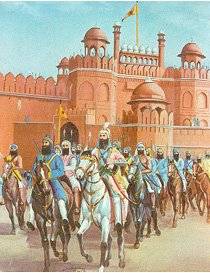
Sardar Baghel Singh Dhaliwal (1730-1802)

Baghel Singh was born in village Jhabal, District Amritsar in a Dhaliwal Jutt family around 1730's. From humble beginnings he arose to become a formidable force in sutlej to Yamuna area. He aligned himself with Karor Singhia misl led by Sardar Karora Singh and succeeded as a leader of Karora Singhia misl in 1765 after early demise of Karora Singh. Karora Singhia misl had 12,000 fighting men according to Syed Ahmad Latif, a Muslim historian.
As well as being a good soldier, Baghel Singh was a very good political negotiator and was able to win over many an adversary to his side. The Mughals, The Ruhilas, the Marathas and British sought his friendship. In the wake of decay of Mughal authority in the Punjab owing to Ahmad Shah Durrani's successive invasions during the latter half of the eighteenth century, the Sikhs began extending their influence. Baghel Singh's Karor Singhia misl fought head on with Ahmad Shah Durrani (also known as Abdali), along with other Dal Khalsa Misals near Kup at Malerkotla, where in one day of battle alone 30-40000 of Women, Children and old Sikhs were martyred.
After Durrani's invasion, Sikhs started consolidating the territories between Yamuna and Indus by incorporating into Misls and misls reporting to Chief of Dal Khalsa Jassa Singh Ahluwalia about territory won at Akal Takht Amritsar. Whereas Sukarchakia misal (of Ranjit Singh) won the territory of Gujranwala, and other areas of Ravi and Chenab Doab and Ramgarhia Misal won the areas of Amritsar, Gurdaspur, Bhangi around Lahore and Kasur, KarorSinghia misal declared their ownership of territories now including Ambala, Karnal, Hissar, Rohtak, Chandigarh, etc. Soon after the Sikh conquest of Sarhind in 1764, he extended his arms beyond Karnal and occupied number of villages including Chhalaudi which he later made his headquarters.
Then Baghel Singh Dhaliwal turned towards cis Yamuna territories and Sikhs were soon invading territories beyond Delhi and into areas like Meerut, Awadh, and collecting tribute from these Nawabs. In February 1764, Sikhs in a body of 40,000 under the Command of Baghel Singh Dhaliwal and other leading warriors crossed Yamuna and captured Saharanpur. They overran the territory of Najib ud-Daulah, the Ruhila Chief, realizing from him a tribute of eleven Lakh of rupees. In April 1775, Baghel Singh with two other Sardars, Rai Singh Bhangi and Tara Singh Ghaiba, crossed the Yamuna to occupy that country, then ruled by Zabita Khan, son and successor of Najib-ud Daulah. Zabita Khan in desperation offered Baghel Singh large sums of money and proposed alliance jointly to plunder the crown-lands. In March 1776, Baghel Singh's forces defeated Imperial Mughal Army near Muzaffarnagar. The whole of Yamuna-Gangetic Doab was not at their mercy.
In April 1781, Mirza Shafi, a close relative of Prime minister of Mughals, captured the Sikh military post at Indri, 10km south of Badavi. Baghel Singh retaliated by attacking Khalil Beg Khan of Shahabad who surrendered with 300 horse, 800 foot and 2 pieces of cannon. On 11 March 1783 Sikhs entered Red for in Delhi and occupied the Diwan-i-Am, the Mughal Emperor, Shah Alam II, made a settlement with them agreeing to allow Baghel Singh to raise Gurdwaras on Sikh historical sites and realize six annas in a rupee of all the Octrai duties and tax collected by state (37.5 %). Baghel Singh stayed in Sabzi Mandi area of Delhi, with 4000 troops, and took charge of the police station in Chandani Chowk. He located seven sites conencted with the lives of the Gurus and had shrines raised thereon within the space of eight months, from April to November 1783. Gurdwara Sis Ganj marked the spot in the main Mughal street of Chandani Chowk where Guru Tegh Bahadur had been executed under the fiat of the emperor. Gurdwara Rikabganj, near modern day Parliament House, where the body was cremated. Bangla Saheb and Bala Sahab commemorated the Eighth Guru, Guru Har Kishan Ji. Three other Gurdwaras were built at Majnu ka Tila, Moti Bagh, and Telivara.
Baghel Singh died probably in 1802, at town of Hariana, in present day Hoshiarpur district. A Samadh enshrining the memory of one of the more picturesque Misal Sardars still stands in the town.
- BACK -